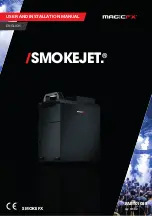
11
INITIAL SETTINGS OF UPPER RUNNING FEED MECHANISM (CONTINUED)
Synchronizing the upper feed with the lower feed can be accomplished by loosening nut (A, Fig. 9) and
moving the ball stud in the upper feed driving shaft segment lever (B). Retighten nut.
CHANGING STITCH LENGTH
Set the stitch to the required length. This is accomplished by loosen-
ing locknut (A, Fig. 10) (it has a left hand thread) and turning the
stitch adjusting screw (B). Turning screw (B) clockwise shortens the
stitch and turning it in a counterclockwise direction lengthens the
stitch.
NOTE:
Any change in stitch length will necessitate a correspond-
ing change in the rear needle guard setting and also
synchronization of the upper running feed mechanism as
described previously.
SETTING THE REAR NEEDLE GUARD
Set the rear needle guard (A, Fig. 11) horizontally so that it barely
contact the rear of the needle (B) when at its most forward point of
travel. It should be set as low as possible, yet have its guarding surface
in contact with the needle, until the point of the looper (C), moving to
the left, is even with the needle. To move needle guard forward or
backward, merely loosen screw (D), move needle guard as required
and retighten screw (D) To raise or lower the needle guard, loosen
screw (D; and turn screw (E) clockwise to lower or counterclockwise to
raise. Retighten screw (D) after guard is properly set.
SETTING FRONT NEEDLE GUARD
Set the front needle guard (F, Fig. 11) so that it barely
contacts the needle (B) until the point of the looper (C),
moving to the left, is just past the left side of the needle.
The looper may brush, but not pick at the needle. The front
needle guard should beset as low as possible to meet this
condition yet not contact the rear needle guard or looper
at any time. To move needle guard forward or rearward,
loosen screws (G), rotate needle guard holder (H) as
required and retighten screws (G). To raise, lower or rotate
needle guard, loosen screws (J), reposition as necessary
and retighten screws after guard is properly set.
THREAD TENSION RELEASE
The thread tension release is set correctly when it begins
to function as the presser foot is raised to within 1/8 inch of
the end of its travel and is entirely released when the
presser foot has reached its highest position.
Fig. 11
Fig. 10
Fig. 9
Summary of Contents for 53700B
Page 7: ...Fig 1 7 ...
Page 13: ...13 EXPLODED VIEWS AND DESCRIPTION OF PARTS ...
Page 14: ...14 ...
Page 16: ...16 ...
Page 18: ...18 ...
Page 20: ...20 ...
Page 22: ...22 ...
Page 24: ...24 ...
Page 26: ...26 ...
Page 28: ...28 ...
Page 30: ...30 ...
Page 32: ...32 ...
Page 34: ...34 ...
Page 36: ...36 NOTES ...
Page 37: ...37 NOTES ...












































